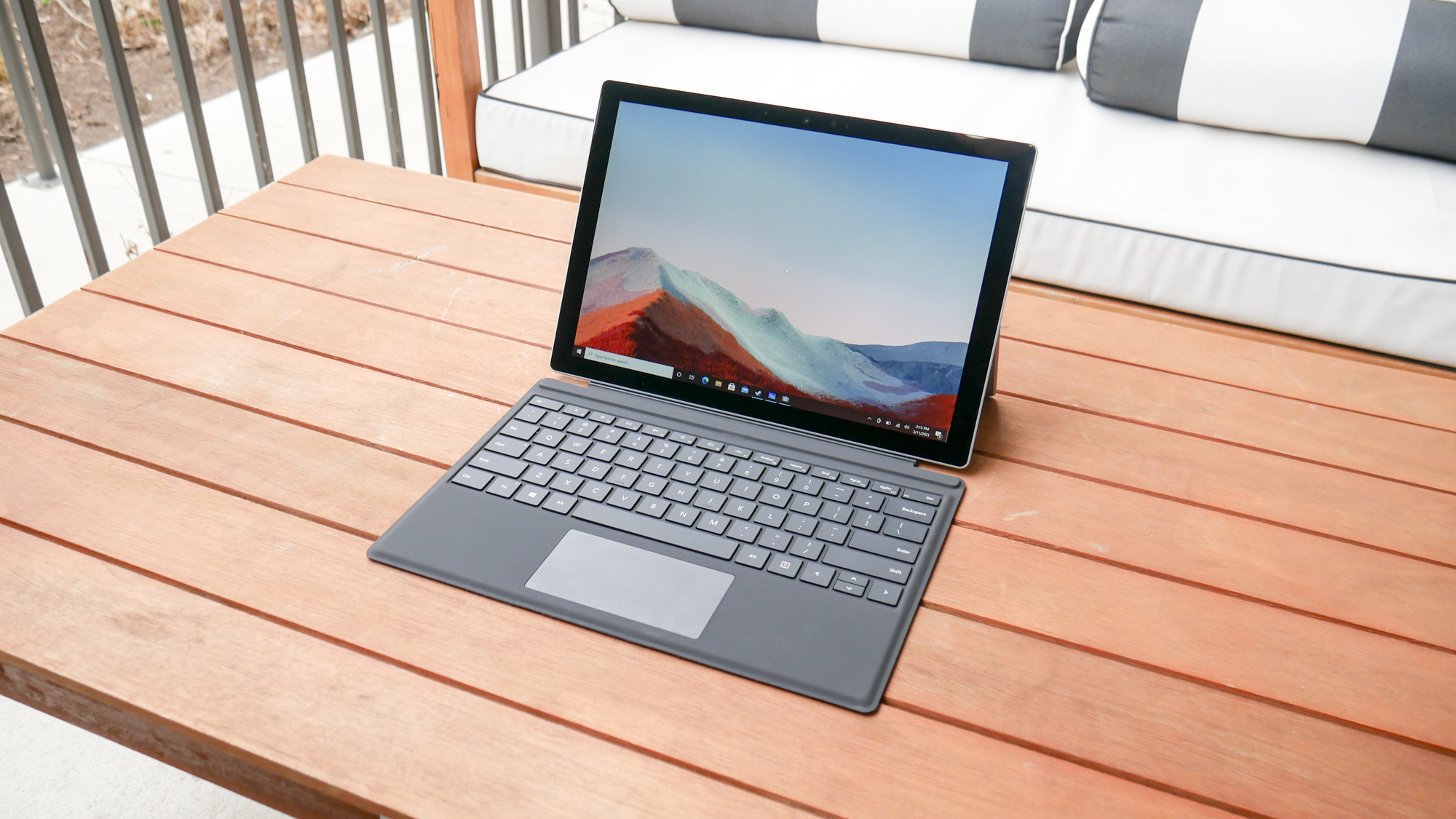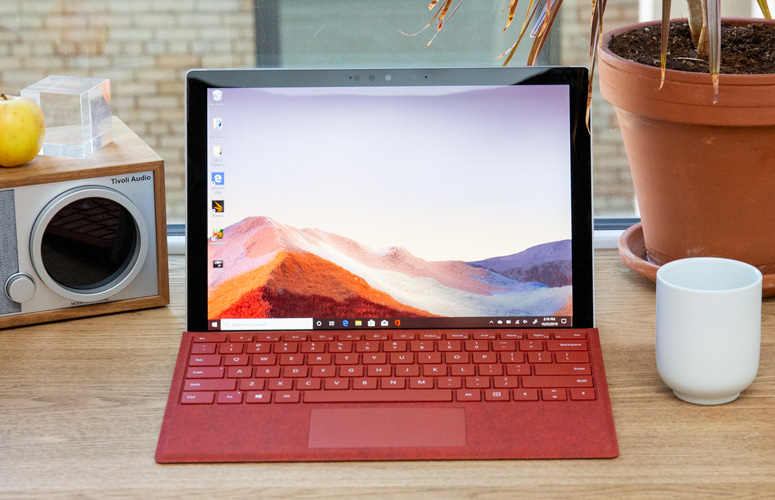Microsoft Surface Pro 7 vs. Surface Pro 7+: Which should you buy?
We help decide which of Microsoft's Surface Pro tablets is right for you

Microsoft carries two Surface Pro models separated in name by a plus symbol. If you're wondering which one you should buy, we don't blame you. The Surface Pro 7+ was released after the Pro 7 and is undeniably an upgrade. But there is a catch: it is only being sold to business users through IT sites like CDW, Staples Advantage and Verizon. That might turn the everyday consumer off, and make them consider getting the aging Surface Pro 7 at their local Best Buy or on Amazon.
While it's already a year old, the Surface Pro 7 remains a good option if you need a portable tablet that can be used as a laptop. Better yet, unlike the Surface Pro 7+, the consumer model can be found at a heavy discount at various retailers. So do you go with value or raw performance? We're going to break down the similarities and differences between these tablets then help you decide which one to buy.
- Surface Pro vs. Surface Laptop vs. Surface Book: Which is best?
- Best tablets in 2021
- Best laptop deals you can buy right now
Surface Pro 7 vs. Surface Pro 7+: Similarities
This won't be a typical face-off where we go through each round looking at how the two systems fare against each other. That's because the Surface Pro 7+ and Surface Pro 7 share many features and components.
So before we go through the differences, let's talk about the similarities between these tablets. First, the Surface Pro 7+ and Surface Pro 7 use the same accessories: the Type Cover keyboard and Surface Pen stylus. These aren't included with the purchase of either unit (you can, however, find Surface Pro 7 bundles) so put aside about $200 if you intend on buying both accessories.

The designs of these tablets are almost identical; we'll spotlight the few differences between them below -- just know that the Surface Pro 7+ isn't much of a redesign. These Surface models also have the same front and rear-camera setup and dual speakers. They even share the same ports (USB-C, Surface Connect, USB Type-A, headphone jack) though the Surface Pro 7+ has a SIM card slot for 4G LTE.
Surface Pro 7 vs. Surface Pro 7+: Value
Having been on the market for more than a year, the Surface Pro 7 has enjoyed considerable price drops and deals. As I write this, the Surface Pro 7 with an Intel Core i5 CPU, 8GB of RAM and a 128GB SSD costs $699, or $200 below its retail price. Opting for 256GB of storage brings the price up to $899, or $300 off the list price.
Still, the Surface Pro 7 can get pretty expensive. The tablet costs $1,299 (originally $1,499) when configured with a Core i7 CPU, 16GB of RAM and a 256GB SSD. Pushing the storage up to a 512GB SSD brings the price to $1,699.
Sign up to receive The Snapshot, a free special dispatch from Laptop Mag, in your inbox.
You won't find much in the way of deals for the Surface Pro 7+. Whereas the Surface Pro 7 is sold at well-known retailers like Amazon, Best Buy and B&H Photo Video, the Surface Pro 7+ can be purchased directly through Microsoft or at IT stores like CDW, Connection or Staples Advantage.
The base Surface Pro 7+ costs $899 and comes with an Intel Core i3 CPU, 8GB of RAM and a 128GB SSD. We recommend spending at least another $100 on the Core i5 model (adding LTE costs another $150).
The Wi-Fi version of the Surface Pro 7+ with a Core i5, 8GB of RAM and a 256GB SSD costs $1,299, or $400 more than the equivalent Surface Pro 7. You will need to spend $1,599 to get a Core i7 CPU, 16GB of RAM and a 256GB SSD. Again, this is $300 more than the consumer version. Upgrading to a 512GB SSD raises the price to $1,999.
Winner: Surface Pro 7
Surface Pro 7 vs. Surface Pro 7+: Design
These two tablets look identical from afar. Get close and you'll spot minor differences that give the Surface Pro 7+ an edge. The newer tablet has a door under the kickstand for accessing the SSD.

You can easily swap the storage drive out using a SIM tool (those little needles that come with your smartphone). Speaking of SIM tools, the Surface Pro 7+ also has a SIM slot because it supports 4G LTE whereas the Surface Pro 7 relies on a Wi-Fi connection.
That's it. Those are the only exterior differences between the Surface Pro 7 and Pro 7+. They're both slim, lightweight magnesium tablets with a flexible kickstand and a connection for the optional Type Cover keyboard attachment. The chunky bezels on the Surface Pro 7+ are no thinner than they are on the Pro 7, so let's hope the upcoming Surface Pro 8 gets a visual refresh.
Winner: Surface Pro 7+
Surface Pro 7 vs. Surface Pro 7+: Display
There isn't much to say here. The Surface Pro 7 and Surface Pro 7+ both have 12.3-inch, 2736 x 1824-pixel touchscreen displays. Based on our testing, Microsoft is using similar panels on these systems.
That's a good thing because the screens are bright, vivid and detailed. They're as good for watching movies and TV shows as they are for crunching numbers, so you'll be happy using these slates for business and leisure alike.

Our testing spotted a few differences between the screens. Covering 75.5% of the DCI-P3 color gamut, the Surface Pro 7+ is more vivid than the Surface Pro 7 (68.7%). Conversely, the Surface Pro 7+'s display reached a maximum average of 358 nits of brightness, making it dimmer than the Surface Pro 7 (395 nits).
It's possible Microsoft is using the same panels and that these differences are within the margin of error to account for any manufacturing variances. Whatever the case, you're getting a really nice display regardless of which tablet you choose.
Winner: Draw
Surface Pro 7 vs. Surface Pro 7+: Performance
The biggest difference between the Surface Pro 7 and Surface Pro 7+ is the engine powering these tablets. The Surface Pro 7+ uses upgraded 11th Gen (Tiger Lake) Intel Core CPUs that deliver faster speeds than the 10th Gen chips in the Surface Pro 7.
Scoring a 4,825 on the Geekbench 5.3 overall performance test, the Surface Pro 7+ topped the Surface Pro 7 (4,443) by around 8.5%. Both tablets beat the premium laptop average (4,160) so you can expect zippy speeds from whichever tablet you're using.

In our real-world test, the Surface Pro 7+ needed 23 minutes and 41 seconds to convert a 4K video to 1080p resolution using the Handbrake app. That is a full 10 minutes faster than the Surface Pro 7 (32:47).
The 256GB SSD in our Surface Pro 7+ unit is sluggish compared with other products in this price range. That said, it topped the Surface Pro 7. The Pro 7+'s storage drive took 1 minute and 17 seconds to convert a 25GB file, equating to a 348.3 megabytes per second transfer rate. The Surface Pro 7's 256GB SSD puttered at a lowly 267.9 MBps. Both are far slower than the 606.1 average for premium laptops.
With integrated Iris Xe graphics, the Pro 7+ will be fine for basic 3D modeling or to run older games. It gets a nice boost over the Iris Plus graphics in the Surface Pro 7, but as we found in our testing, neither tablet is meant for running graphics-demanding apps.
Winner: Surface Pro 7+
Surface Pro 7 vs. Surface Pro 7+: Battery life
Another area where the Surface Pro 7+ topples its consumer sibling is battery life. We were relieved to see some improvements considering the Surface Pro 7 struggled on our endurance test, lasting only 7 hours and 30 minutes.

The Surface Pro 7+ does better, powering down after 8 hours 49 minutes, but that is still less than what we expect from a modern premium device, and it's considerably worse than the 10 hour and 5-minute category average.
Winner: Surface Pro 7+
Surface Pro 7 vs. Surface Pro 7+: Which is best?

The Surface Pro 7+ is the better of these two tablets, but that doesn't mean we would recommend it. Price should be a major factor in deciding between these two slates. As it stands, the Surface Pro 7 is up to $400 cheaper than a Surface Pro 7+ with comparable specs. Unless you absolutely need a swappable SSD or 4G LTE connectivity, we recommend saving some money and going with the Surface Pro 7.
Yes, the Surface Pro 7+ brings faster performance, but you probably won't notice much of a speed boost in your day-to-day workflow. And while the business-oriented tablet has longer battery life, the extra hour or so of runtime isn't worth the added cost in our book. If money isn't a factor, and you're deciding between these two, go with the Surface Pro 7+ for various, albeit, minor advantages.
Not sold on either tablet? Check out the Lenovo ThinkPad X1 Detachable, a direct competitor to the Surface Pro 7 that does a lot of things better. Or, you could wait for the Surface Pro 8 to arrive later this year.
Phillip Tracy is the assistant managing editor at Laptop Mag where he reviews laptops, phones and other gadgets while covering the latest industry news. After graduating with a journalism degree from the University of Texas at Austin, Phillip became a tech reporter at the Daily Dot. There, he wrote reviews for a range of gadgets and covered everything from social media trends to cybersecurity. Prior to that, he wrote for RCR Wireless News covering 5G and IoT. When he's not tinkering with devices, you can find Phillip playing video games, reading, traveling or watching soccer.

